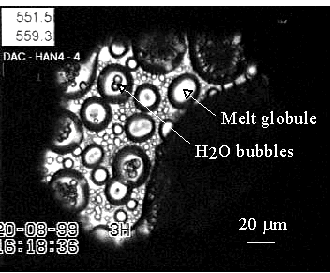

The expansion of volatiles exsolved from magmas is the major driving force of explosive volcanic eruptions. The process starts with bubble nucleation in a supersaturated melt and continues with growth of the bubbles by mass transfer from the melt into the gas phase and volatile expansion as the confining pressure decreases. These processes are complex and depend on many parameters, such as melt viscosity (which in turn depends on temperature, melt composition and water content), time, initial and final pressure. Up to now, only a few in-situ experiments have been performed at atmospheric pressure. These have allowed study of bubble growth by water diffusion from a supersaturated melt and subsequent viscous expansion. However, to date there have been no studies of gas volume expansion under decompression, as it occurs in nature, during the vesiculation of ascending magmas. The present project is the first in-situ high pressure-temperature study of bubble nucleation and growth using a Bassett-modified hydrothermal diamond-anvil cell (DAC), operating up to 1100°C and 2.5 GPa, and using water as the pressure medium.
Starting materials are thin slabs (<100 µm thick, ˜300 µm diameter) of haplogranite glass loaded in the DAC sample chamber together with water and an air bubble. The first step of the experiment is hydration of the melt at a given temperature. This defines the pressure and therefore the melt water content (both calculated after the experiment). The second stage of the experiment is a temperature decrease (at rate of ˜30°C/s), leading to decompression. During decompression, water exsolves from the supersaturated melt until the glass transition temperature is reached. The nucleation and growth of bubbles can be observed in detail in video recordings of the experiments. Precise measurements of bubble size are made on images captured from these video recordings (Fig. 3.6-4).
 |
Fig. 3.6-4: Bubble growth during temperature drop from 818 to 560°C (decompression from 1.3 to 0.84 GPa, water exsolution from 14.1 to 12.4 wt%). Water bubbles expanded up to 6.2 µm in 9.4 s. |
Before the temperature drop, the initial pressures range from 0.79 to 2.19 GPa, corresponding to an initial melt water content between 10.9 and 20.3 wt%. During decompression (about 0.3 to 0.5 GPa), bubbles grow in a few seconds, corresponding to a water exsolution of 1-2 wt%, and to glass transition temperatures of 540-580°C. No time delay has been observed during bubble nucleation or growth, in agreement with the low viscosities calculated for this haplogranite composition (˜103 Pa.s, when extrapolated to water contents >8 wt%). Bubble sizes have been compared to those predicted by recent numerical models, all assuming isothermal and isobaric bubble growth. During our experiments, pressure and temperature decrease continuously, so the models were modified to incorporate the temperature and pressure effects on water diffusivity, melt and gas viscosity and density. Secondly, bubble growth in the haplogranitic starting composition can be compared to models of bubble growth in silicic melts, but these models are valid only for viscosity >104 Pa.s. However, we found that for decompression starting at ˜1.2 to 1.3 GPa, the models and the experiments are in agreement. For higher initial pressures (e.g., 2.1 GPa), the models drastically underestimate the bubble sizes, but overestimate them at lower initial pressures. Comparisons with vesiculation models in basaltic melts, for which the viscosity is relevant but not the composition, are now in progress.

Tel: +49-(0) 921 55 3700 / 3766, Fax: +49-(0) 921 55 3769, E-mail: bayerisches.geoinstitut(at)uni-bayreuth.de
 Previous page
Previous page